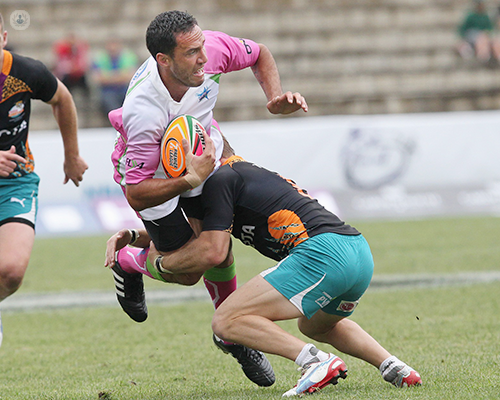Knee injuries and rugby: advancements in minimally invasive surgery
Escrito por:Treating a knee injury used to be much more complex in the past. However, orthopaedic surgeons such as Mr Amer Khan are able to provide faster and minimally invasive treatment. Mr Khan (a renowned knee and shoulder surgeon who specialises in sports injuries) explains how this is possible.

How common are knee injuries in rugby?
Knee injuries are becoming more and more common due to the high demands being placed on the joints. This demand is made by
- The expectation that players need to be faster and more agile.
- Tackles becoming harder as the general speed and strength of players increase.
Knee injuries cause the most absent days for rugby players. In fact, ACL (anterior cruciate ligament) and MCL (medial collateral ligament) injuries make up over half of all absent days at matches.
Is surgery always necessary?
In some injuries, only one ligament may be affected, but multiple ligaments can be damaged in the same injury. If only the MCL is injured, it might be able to heal without surgery. If the injury involves a combination of the ACL and the MCL, or the ACL alone, surgery is much more likely to be necessary if the player wants to return to the sport.
In the past, the traditional treatment involved letting the MCL heal and then surgically treating the ACL. However, nowadays we can treat both at the same time with minimally invasive surgery.
What are the aims of surgery?
When repairing the MCL, it can be stabilised by using a small device. This device is an internal brace and it’s placed via two small incisions – one just below the knee and another just above the knee. Sometimes a more extensive repair reconstruction (replacement of the MCL) is required.
When treating the ACL, the traditional method is to perform an ACL reconstruction – this uses the patient’s own tendons. These are most often taken from the knee cap (the patellar tendon) or the hamstrings. With new surgical advancements, we no longer have an ACL reconstruction as the only option in select cases – we can now repair it and eliminate the need for using a patient’s tendons.
How does an ACL repair work?
To achieve an ACL repair, we first pass a synthetic device through the ACL to support it. Once stable, we can apply techniques to release stem cells. As a result, the ACL can heal using the body’s self-healing capability and other tendons from the body aren’t needed.
This is a keyhole procedure that is generally a day surgery. Despite the relatively quick procedure, crutches will be necessary for at least a few weeks. Recovering from ACL repair procedures maybe faster than recovering from ACL reconstructions. This is because tissue (the patient's tendons) are not removed and placed. However, in the majority of cases, an ACL reconstruction remains the gold standard. Using modern minimally invasive techniques for harvesting graft ACL reconstruction is a successful operation with excellent outcomes.
What makes an ACL suitable for repair?
The key element when considering ACL repair is to get referred to a soft tissue knee surgeon (who is fellowship-trained in ligament surgery) as soon as possible. With an early referral, your chances of being eligible for the procedure increase.
Would you like to know more? Mr Khan’s first-class orthopaedic services are available via video and face-to-face consultation. Learn more and arrange your first consultation.


